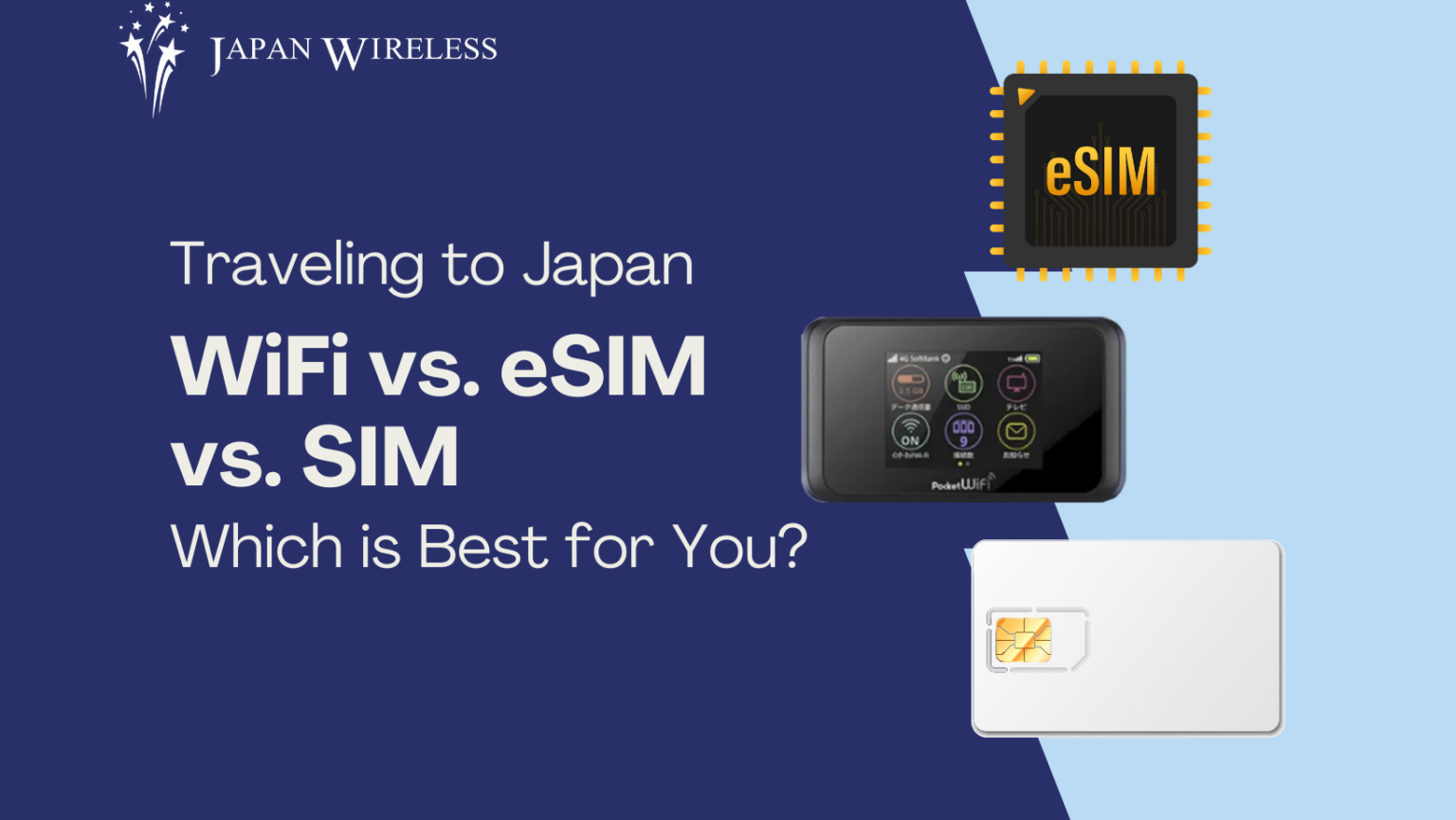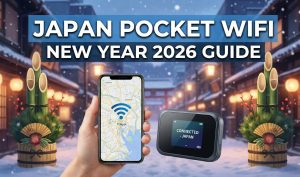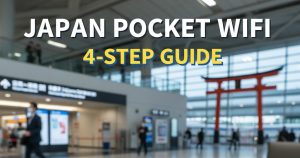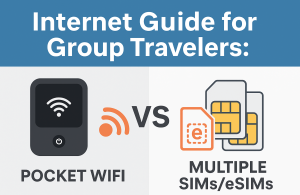To ensure you don’t miss any updates while traveling, staying online is essential. Whether for work, keeping in touch with family, or navigating new places, reliable internet access is a must. Japan has limited public internet access, and roaming can result in unexpectedly high charges. Instead, consider three popular options for travelers in Japan: Pocket WiFi, eSIM, and SIM cards.
This guide compares these options to help you pick the best Japan WiFi solution tailored to your travel style and device.
1. Japan Pocket WiFi
Pocket WiFi (or portable wifi) that provides internet access by creating a personal WiFi hotspot. It connects to mobile networks and allows multiple devices to connect to the internet simultaneously.
Advantages of Japan Pocket WiFi
- Multi-device connectivity: One of the biggest advantages of Pocket WiFi is its ability to connect multiple devices and users simultaneously.
- Easy setup: Simply turn on the device and connect to the internet using the provided SSID and password.
- High-speed internet: Provides stable and fast internet speeds, ideal for streaming, video calls, and other high-bandwidth activities.
Disadvantages
- Extra device required: Carrying an additional device can be cumbersome, especially if you prefer to travel light.
- Pickup required: You have to pick up the device at Narita Airport, Haneda Airport and designated wifi counter.
- Order in advance: For certain pick-up locations, you can arrange same-day or 2-hour pickup with providers like Japan Wireless, but generally, it is recommended to book your wifi in advance.
2. Japan eSIM
An eSIM (embedded SIM) is a digital SIM that can be activated with a QR code and is embedded directly in your device.
Advantages of Japan eSIM
- Convenience: Easily switch between carriers and plans without needing to replace a physical SIM card.
- No extra device: As it’s embedded in your device, there’s no need to carry a portable WiFi device or store physical SIM cards.
- Immediate activation: Plans can be activated almost instantly, without waiting for a package to be shipped or or pick up at airport counters in Japan.
Disadvantages
- Device compatibility: Not all devices support eSIM. Ensure that your device is compatible with eSIM and is unlocked before opting for this option.
- Single-device use: An eSIM can be installed on only one device at a time. However, you can share the internet with other devices or people via the hotspot function.
3. Japan SIM Card
A SIM card is a small, removable card that stores your mobile network information and allows your device to connect to a carrier’s network. Many providers offer 3-in-1 SIM cards, which can be adjustable and compatible with various SIM card trays.
Advantages of Japan SIM Card
- No return needed: While you still need to pick up the SIM card, you can simply dispose of it when you’re done.
- Cost-effective: Generally, purchasing a local SIM card at your destination can be one of the most affordable options for short-term travel.
- Widespread availability: Physical SIM cards are widely available and supported by almost all mobile devices and carriers.
- Single-device use: Like an eSIM, a SIM card can only be set up for one device at a time and users can share the internet through hotspot.
Disadvantages
- Inconvenience: Physically swapping SIM cards can be cumbersome, especially if you need to change them frequently. You might also require a SIM ejector tool and could risk losing your primary SIM card during the switch.
- Compatibility Issues: Some smartphones are SIM-locked, so be sure to check compatibility before purchasing.
Connection in Japan: Which One Should You Choose?
To pick the most suitable internet connection option for your travels to Japan, here’s everything you need to know.
Japan WiFi Options Compared
| Feature | Pocket WiFi | eSIM | SIM Card |
| Multi-device connectivity | Yes | No (Hotspot sharing available) | No (Hotspot sharing available) |
| Ease of Setup | Easy, just turn on and connect | Easy, activate with QR code or manual setup | Moderate, physically swap and configure settings |
| Internet Speed | High, stable | High, depends on carrier | High, depends on carrier |
| Battery Life | Requires charging
(~8-12 hrs) |
N/A | N/A |
| Extra Device | Yes | No | Maybe (SIM ejector tool) |
| Device Compatibility | Works with any WiFi-enabled device | Requires eSIM-compatible device | Works with any unlocked device supporting SIM |
| Pickup | Yes (Haneda, Narita, Kansai, Hotel delivery) | No | Yes |
| Return | Yes | No | No |
| Flexibility | High (portable and shareable) | Very high (easy to switch carriers) | Moderate |
| Ideal for | Solo travelers and group travelers needing access for multiple devices | Frequent travelers and solo travelers who require instant internet access | Solo travelers concerned about eSIM compatibility |
Which Japan WiFi Option is Right for You?
Japan Pocket WiFi
This is an ideal choice for group travelers or those with multiple devices. It provides convenient and reliable internet access for several devices, though it requires carrying and charging the device. Various shipping options are available, including pick-up at major Japanese airports (Narita, Haneda, Kansai), hotels, or post offices. Moreover, most providers also offer postal return options.
<Check Japan Pocket Wifi Rental by Japan Wireless>
Japan eSIM
Japan eSIM is optimal for frequent travelers and solo trips who want hassle-free internet without extra devices. It’s highly recommended if your device supports eSIM and you want instant activation without pickups.
<Check Japan eSIM by Japan Wireless>
Japan SIM Card
Japan SIM cards are recommended for solo travelers on a budget, and your device does not support eSIM, a local SIM card is a reliable alternative. While it may require some setup, it generally offers the best rates for local data and provides a stable connection.
<Check Japan SIM by Japan Wireless>
How to Get Japan WiFi?
- Pocket WiFi: Reserve online in advance, then pick up at airport counters (Narita, Haneda, Kansai) or have it delivered to your accommodation. Some providers like Japan Wireless offer same day WiFi rental with quick pickup.
- eSIM: Purchase online, receive a QR code via email, and activate instantly on your compatible device. No pickup or return needed.
- SIM Card: Buy at airports, electronics stores, or online for delivery. Insert the SIM before or upon arrival.
Conclusion
Choosing between Pocket WiFi, eSIM, and SIM cards depends on your travel styles, device compatibility, and connectivity needs. Pocket WiFi is best for connecting multiple devices. For flexibility and ease of switching carriers, eSIM is optimal. Lastly, For cost-effectiveness and device compatibility, a Japan SIM card works well.
Evaluate your trip length, devices, and preferences to select the best Japan WiFi option and stay connected effortlessly.









